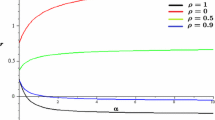Abstract
The dynamics of a population inhabiting a heterogeneous environment are modelled by a diffusive logistic equation with spatially varying growth rate. The overall suitability of an environment is characterized by the principal eigenvalue of the corresponding linearized equation. The dependence of the eigenvalue on the spatial arrangement of regions of favorable and unfavorable habitat and on boundary conditions is analyzed in a number of cases.
Similar content being viewed by others
References
Brown, K. J., Lin, C. C.: On the existence of positive eigenfunctions for an eigenvalue with an indefinite weight function. J. Math. Anal. Appl. 75, 112–120 (1980)
Cantrell, R. S., Cosner, C.: Diffusive logistic equations with indefinite weights: population models in disrupted environments. Proc. Roy. Soc. Edinb. 112, 293–318 (1989)
Figueiredo, de D. G.: Positive solutions of semilinear elliptic problems. In: Figueiredo, D. G. de, Honig, C. S. (eds.) (Lect. Notes Maths., vol. 957, pp. 34–88). Berlin Heidelberg New York: Springer 1982
Levin, S.: Population models and community structure in heterogeneous environments. In: Hallam, T. G., Levin, S. (eds.) Mathematical ecology (Lect. Notes Biomath., vol. 17). Berlin Heidelberg New York: Springer 1986
Ludwig, D., Aronson, D. G., Weinberger, H. F.: Spatial patterning of the spruce budworm. J. Math. Biology 8, 217–258 (1979)
MacArthur, R. H., Wilson, E. O.: The theory of island biogeography. Princeton: Princeton University Press, 1967
Manes, A., Micheletti, A. M.: Un' estensione della teoria variazionale classica degli autovalori per operatori ellitici del secondo ordine. Boll. U.M.I. 7, 285–301 (1973)
Murray, J. D., Sperb, R. P.: Minimum domains for spatial patterns in a class of reaction-diffusion equations. J. Math. Biology 18, 169–184 (1983)
Newmark, W. D.: Species-area relationship and its determinants for mammals in western North American national parks. Biol. J. Linnean Soc. 28, 83–98 (1986)
Okubo, A.: Diffusion and ecological problems: mathematical models. Berlin Heidelberg New York: Springer 1980
Seno, H.: Effect of a singular patch on population persistence in a multi-patch system. Ecol. Modell. 43, 271–286 (1988)
Skellam, J. G.: Random dispersal in theoretical populations. Biometrika 38, 196–218 (1951)
Soule, M. E., Wilcox, B. A. (eds.): Conservation biology: an evolutionary-ecological perspective. Sunderland, Mass.: Sinauer 1980
Author information
Authors and Affiliations
Additional information
Research supported by National Science Foundation grant #DMS 88-02346
Rights and permissions
About this article
Cite this article
Cantrell, R.S., Cosner, C. The effects of spatial heterogeneity in population dynamics. J. Math. Biol. 29, 315–338 (1991). https://doi.org/10.1007/BF00167155
Received:
Revised:
Issue Date:
DOI: https://doi.org/10.1007/BF00167155




